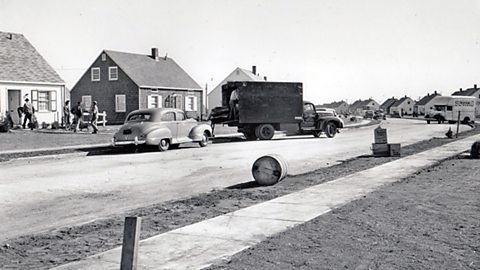The American dream
After World War Two, America enjoyed an economic boomA period when the economy expands and grows. The American dreamThe idea that everyone in the USA has the chance to be successful and happy if they work hard. gave Americans hope that they could enjoy a comfortable standard of living and be successful if they worked. This ideal was becoming more of a reality again for millions. In the post-war period, Americans enjoyed peace, prosperity and new forms of popular culture.
Explore how World War Two changed America through animation and archive footage.
Post-war prosperity
The 1944 G.I. Bill of Rights helped America to avoid a post-war recessionA time of temporary economic decline when trade and industrial activity are reduced. By the early 1950s, the federalPart of the government of the USA as a whole rather than relating to an individual state. government had spent around $13 billion on education, training, housing and business loans for Americans who had served in the military during the war.
In 1946, there was a record number of births in the USA. This generation became known as the baby boomers. This rise in population created a huge demand for more housing. To meet this need, homes were mass produced in new suburbsThe outskirts of a town or city. like āL±š±¹¾±³Ł³Ł“Ē·É²Ō²õā, created by the Levitt and Sons company. These homes typically included a white picket fence, green lawns and modern household appliances. Millions of Americans were able to afford these homes. Suburban home ownership became a key feature of the American dream.

The growth of suburbs created a new lifestyle and fuelled consumerismThe increased purchasing of products and goods. Refrigerators, cars and television were in high demand. In 1956, the Federal Aid Highway Act led to the construction of a national system of highways, which improved the road network and connected the country. This enabled access to new shopping malls as well as drive-in movie theatres and restaurants.
President Harry S Trumanās Fair Deal
When President Franklin D Roosevelt died in April 1945, his vice president Harry S Truman replaced him. Truman was also elected to the presidency in his own right in 1948. He continued the legacy of Rooseveltās New Deal and created his own social reform plan called the Fair Deal. It had mixed results. Truman was able to:
- desegregationRemoval of laws that separate people from different races in public places and day-to-day life. the military through executive orderAn order signed by the US president directing government departments to do certain things. Executive orders do not require approval from Congress.9981 in 1948
- almost double the minimum wage, from 40 cents to 75 cents per hour
- improve the coverage of social securityFinancial assistance given by the state to individuals with a very low income or none at all.
- provide funds for slum clearance and the development of low-cost housing
- create a commissionA group of people who are asked to investigate something. to investigate the problems of racial injustice in America
However, Truman was unable to:
- introduce a national health insurance scheme - this was rejected by Republican PartyOne of the two major American political parties. Republicans tend to hold a more conservative viewpoint on politics and society. in CongressThe legislative body of the US government, made up of the Senate and the House of Representatives. and condemned by the American Medical Association as "socialised medicine"
- get any civil rights laws passed in Congress because the southern Democratic PartyPolitical party in the United States. Democrats tend to hold a more liberal viewpoint on politics and society. who held power in the southern states, opposed them